This Olive and Pepper-Stuffed Pork Loin is a show-stopping centerpiece for any special meal.
Juicy pork loin is stuffed with olives, roasted red peppers, garlic, basil and more for a fun, Italian-inspired dinner.
Plus it looks fancy but it’s easier to make than you might think. I’ll walk you through the simple steps.
And it just happens to naturally be gluten-free, dairy-free, keto, Paleo and Whole30 compatible!
(As an Amazon Associate, I earn from qualifying purchases. Some of the links on this page may be affiliate links. If you purchase a product through an affiliate link, I’ll automatically receive a small commission at no additional cost to you.)
Italian Stuffed Pork Loin
Boneless pork loin is a lean protein that can be a bit bland on its own.
So we’re going to butterfly the loin (opening it up, almost like a book) so we can spread over it a savory paste of olives, red peppers, garlic and more.
And instead of using breadcrumbs in the filling like other stuffed pork loin recipes, we’ll be using a mashed potato. It helps thicken the filling while keeping it gluten-free. Hidden veggies FTW!
Then we roll it up, tie it up and roast it! You end up with juicy pork and an umami-packed filling.
And we’ll create a simple, glossy sauce with butter and balsamic vinegar to drizzle over the top.
So this pork loin recipe is perfect for Christmas, Easter, any celebratory meal or if you just want a special Sunday night dinner.
What you need for this stuffed pork loin roast
Ingredients:
- 3.5-4 lbs. boneless pork loin with the fat cap still attached (the wide, thin layer of fat running along one side of the loin – this will help keep the pork juicy)
- 1 large Russet potato
- 6 oz. jar pitted Kalamata olives
- 12 oz. jar roasted red peppers
- 1 tablespoon drained capers
- 4 anchovies, packed in oil or anchovy paste (if you don’t like anchovies, I promise you don’t taste them specifically, they just add a briny, salty boost of umami; you can leave them out but then you’ll need to add more salt to the filling)
- 1/3 cup packed fresh basil
- 3 garlic cloves
- red pepper flakes (optional)
- red wine vinegar
- Italian herb seasoning
- fine sea salt
- black pepper
- avocado oil or olive oil
- balsamic vinegar
- butter or ghee (for Paleo/Whole30)
Equipment:
- a large, oven-safe skillet (I use a 12″ cast iron skillet) or small, stovetop-safe roasting pan than can fit the pork loin
- a cutting board, especially one with a moat running around the edge
- a chef’s knife
- a boning knife (optional but helpful)
- a meat mallet
- measuring cups
- measuring spoons (these are my favorite because they actually fit into spice jars!)
- a measuring glass
- a medium mixing bowl (I bought a set like this so I could have a mixing bowl in every size)
- a small offset spatula (optional but helpful)
- kitchen twine
- kitchen tongs
- aluminum foil
- a wooden spoon or spatula
How to make a stuffed pork loin
The instructions look long but it takes longer to explain how to do it than to actually do it.
First, we’ll create the filling.
Microwave the potato: stab the potato 4-5 times with a fork and microwave it for 7-8 minutes, flipping it once halfway through. Let cool.
Make the olive and pepper mixture: In a food processor, combine the drained olives, red pepper, capers, anchovy, basil, garlic, red pepper flakes (if using) and pepper. Pulse 4-5 times until you get a chunky paste. Taste and add salt if necessary. The olives, capers and anchovies all are salty on their own so you might not need any more.
No food processor? You can also chop everything somewhat finely by hand and stir together.
Peel the potato. In a mixing bowl, mash the potato until fairly smooth. Save 2/3 cup of the mashed potato in the bowl. Save any extra for another use.
Combine the potato and olive mixture. Add 1 cup of the olive mixture to the 2/3 cup potatoes along with the red wine vinegar and 1/2 teaspoon of salt. Stir until blended. Taste and add more salt if necessary. It might already taste a little salty at this point. That’s okay! It’ll get spread thin in the pork loin, diffusing the saltiness.
Heat the oven to 375°.
Now for the pork (see pics in the recipe below):
Lay the pork loin fat cap-side down on a cutting board with one of the short ends facing you.
Using a chef’s knife or boning knife, make one slice running down the length of the pork about 1/2″ in from the right side (if you’re right-handed).
Now keeping the blade of the knife flat and parallel to the cutting board and about 1/2″ up from the cutting board, keep slicing down the length of the loin over and over again. Make sure to keep the blade flat – it will have a tendency to want to angle upward.
As you slice with one hand, pull open and unroll the pork as you go. Stop slicing about 1/2″ before cutting through the loin entirely.
Now you should be able to open the loin like a book. However, the left side will be thicker than the right. Now start a new slice down the length of the loin at the seam and repeat the process until you can open the loin a second time.
Don’t worry if you see a lot of cuts running up and down the loin. They’ll be hidden when you roll it up.
Cover the loin with plastic wrap and use the flat side of a meat mallet to pound any thicker areas so the loin is an even thickness.
Flip the loin over and season the fat cap side with the salt, pepper and Italian seasoning.
Flip it back over again so the fat cap side is down and season with just salt (there’s already pepper in the filling).
Spread the paste over the loin, stopping about 1″ before all the edges. A small offset spatula is helpful here but you can also use a regular spatula or even your hands.
Starting on the left side, roll up the loin. Don’t press too hard or you’ll squeeze the filling out (it’s okay if some falls out the sides). The fat cap should be facing up at this point.
Cut 6 pieces of kitchen twine, about 12″ long. Slide them under the loin so they’re spread out evenly.
Tie each string with a knot and trim the excess string.
You did it! Bask in the glory of your rolled and stuffed pork loin.
Heat the oil in the skillet over medium high heat.
Place the loin fat cap-side down in the skillet to sear the fat for about 5-6 minutes.
Use tongs to flip the loin over so the fat cap is facing up. Place the skillet in the oven and bake for about 25-30 minutes, or until a thermometer reads about 145°. Make sure the thermometer is only going into the pork itself, not the filling (stab it in a few different places to make sure).
Take the loin out of the oven, place it on a cutting board and cover it loosely with aluminum foil. Let it rest for 10 minutes. This will help make sure all the juices don’t run out when you slice into it.
To make the sauce: remove any chunks of filling or fat that may have fallen out of the loin into the skillet. Put the skillet over medium heat.
Add the balsamic vinegar to the pan. Now stir in the butter or ghee one tablespoon at a time until you have a thick, glossy sauce.
Cut and remove the strings, slice the pork and carefully arrange the slices on a serving platter. Drizzle the sauce over the top and serve.
How long to cook stuffed pork loin
Because the loin is pounded thin and rolled, it doesn’t need as long as if you cooked it whole.
As I said above, this stuffed pork loin needs about 25-30 minutes.
This time holds true if you want to cut the recipe in half and use 2-2.5 pound pork loin. It would still need about 25-30 minutes.
What to make ahead
You can make the olive and pepper mixture up to a week in advance and kept in the fridge.
The potato can be cooked, peeled and mashed up to 3 days in advance and kept in the fridge.
Leftovers
You’ll have some of the olive mixture left over – lucky you! Bring it to room temperature before you try any of the following:
- Toss with hot spaghetti noodles and maybe a touch of the spaghetti’s cooking water to create a thick, flavorful sauce
- Mix into scrambled eggs or spoon on top
- Spread it in a sandwich, grilled cheese or panini
- Spoon on top of chicken, pork chops, or seafood (salmon, white fish, shrimp, etc.)
Any leftovers of the stuffed pork loin can be kept in the fridge for up to 5 days. Warm it up in the microwave or a low oven.
You can store any of the balsamic sauce separately for up to a week in the fridge. Warm it up in a small saucepan on the stove over lower heat.
Cutting the recipe in half
You can cut the recipe in half by using a 2-2.5 lb. boneless pork loin. You can either make the filling as is but only use enough to cover the butterflied pork (which means lots leftover! See ideas above) or cut the filling ingredients in half as well. The cooking time will remain the same.
What to serve with stuffed pork loin
I think one starchy vegetable and one green vegetable would make the perfect plate with this pork loin recipe.
Mashed potatoes, mashed sweet potatoes, mashed butternut squash or mashed parsnips would all be delicious. I used mashed pumpkin in the pics here.
Steamed broccoli or sautéed spinach, kale or green beans would be great.
These roasted green beans and Brussels sprouts would also be delicious.
This braised red cabbage would add a gorgeous ruby color to your plate.
Carrots sliced and sautéed in butter would also be great.
And for dessert?
This Olive Oil Polenta Cake would be perfect.
And this Flourless Chocolate Espresso Cake is a crowd-pleaser.
If you’re making this for Easter, this Italian Cassata Cake is a great Easter dessert.
If this is for Christmas, you could also pass around these mini rosemary rum pecan pies.
Other pork recipes:
- Christmas-Spiced Pork Tenderloin (Paleo, Whole30)
- Slow-Cooker Espresso Pulled Pork (Paleo, Whole30)
- Apple Cider Pulled Pork (Paleo, Whole30)
- Creamy Mustard Pork Chops (Paleo, Whole30)
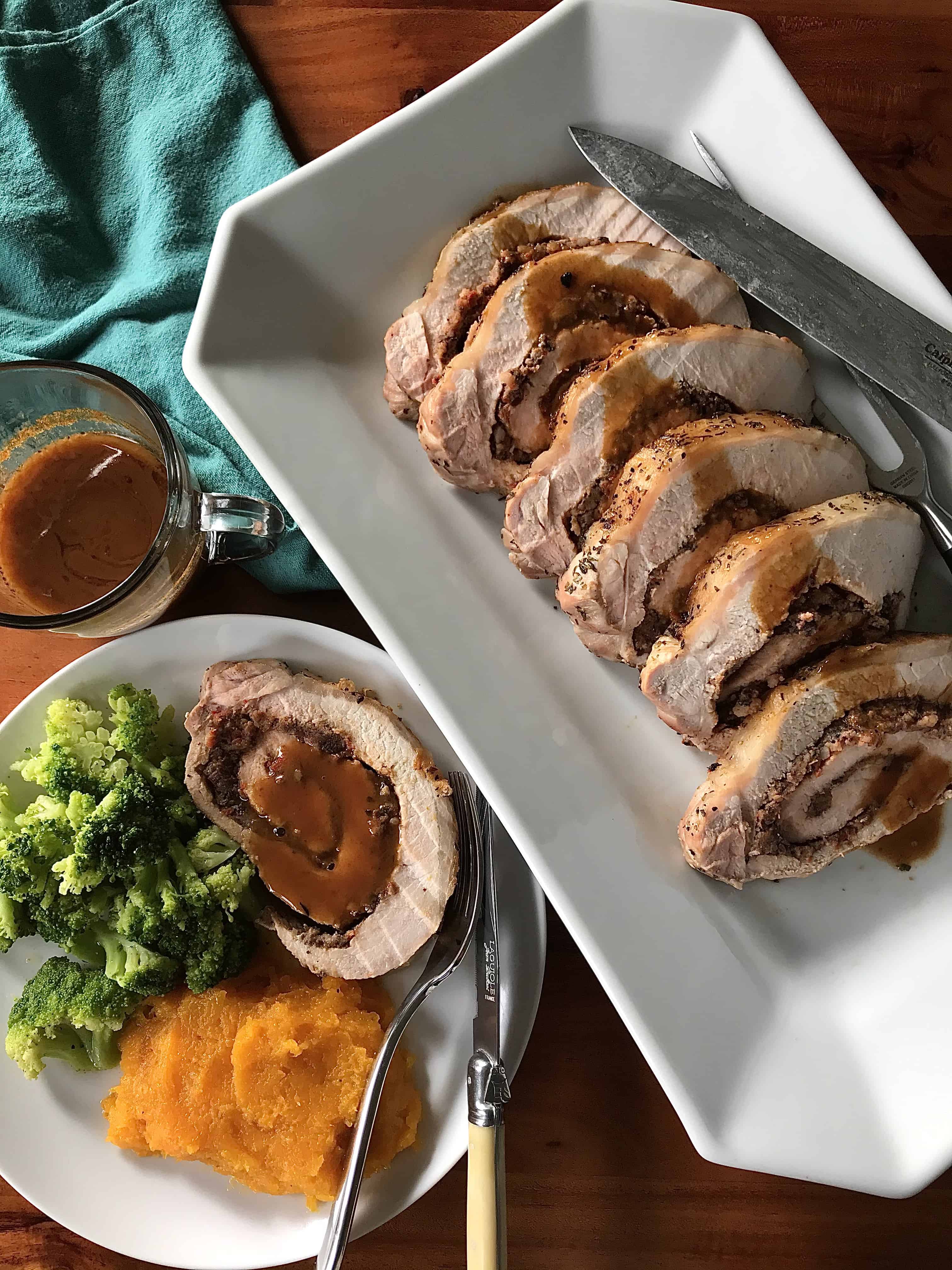
Olive and Pepper-Stuffed Pork Loin
Ingredients
- 1 large Russet potato
- 6 oz. jar pitted Kalamata olives, drained
- 12 oz. jar roasted red peppers, drained
- ⅓ cup packed basil, roughly torn
- 1 tablespoon capers packed in brine, drained
- 4 anchovy fillets packed in oil, patted dry and roughly chopped (or 1 teaspoon anchovy paste)
- 3 garlic cloves, peeled and roughly chopped
- ½ teaspoon red pepper flakes (optional)
- ½ teaspoon ground black pepper, plus more as necessary
- ½ teaspoon fine sea salt, plus more as necessary
- 1 teaspoon red wine vinegar
- 3½-4 pounds boneless pork loin with its fat cap intact
- 2 teaspoons Italian seasoning
- 1 tablespoon olive oil or avocado oil
- ¼ cup balsamic vinegar
- ¼ cup butter or ghee (for Paleo/Whole30)
Instructions
- Stab the potato with a fork 4-5 times. Place on a microwave-safe plate and nuke for 7-8 minutes, flipping it once halfway through. Let cool. Peel and mash.
- In a food processor, add the olives, peppers, basil, capers, anchovies, garlic, red pepper flakes (if using) and ½ teaspoon black pepper. Pulse 4-5 times until it's a chunky paste.
- In a medium mixing bowl, combine ⅔ cup of the mashed potato, 1 cup of the olive mixture, the red wine vinegar and ½ teaspoon salt. Stir until blended. Taste and add more salt if necessary. It might already taste really salty and that's okay! It'll get dispersed evenly through the pork loin. Set the mixture aside. (No food processor? You can also chop everything somewhat finely by hand and stir together.)
- Heat the oven to 375°.
- Cut six 12"-long pieces of kitchen twine and set aside next to where you'll be working with the pork.
- Place the pork loin on the cutting board with one of the short sides closest to you.
- Flip the loin over so the fat cap is facing down. Slice down the length of the loin about ½" in from the right side (if you're right-handed).
- Now turn the knife so the blade is flat and parallel with the cutting board, about ½" up from the board. Slice down the length of the loin, making sure your knife doesn't angle up or down.
- Keep slicing down the length of loin. Pull the pork open as you cut. Stop about ½" from the other long side. Lay the loin open like a book and repeat the process until you can open up the loin a second time.
- Cover the loin with plastic wrap and use the flat side of a meat mallet to pound any thicker areas so the loin is an even thickness.
- Flip the loin over so the fat cap is facing up. Season the whole surface with salt, pepper and the Italian seasoning.
- Flip the loin over again so the fat cap is facing down. Season the whole surface with salt.
- Using a small offset spatula, a regular spatula or your hands, spread the olive and potato mixture evenly across the surface of the loin, stopping about 1" from the edges.
- Roll up the loin from the long side on the left. Don't press too hard so you don't squeeze the filling out the sides (that being said, if some naturally falls out, that's fine).
- Slide the pieces of string under the pork, evenly spreading them out. Tie each piece firmly (but again, not super tight) and trim any excess string.
- Heat the oil in a large oven-safe skillet or small, stovetop-safe roasting pan over medium-high heat.
- Place the loin in the pan fat cap-side down. Sear the fat until golden brown, about 5-6 minutes.
- Flip the loin so the fat cap is facing up. Place in the oven for 25-30 minutes, until a thermometer inserted into the meat reads 145°. Make sure the thermometer tip isn't actually in the filling (stab the pork in a few different places to make sure).
- Remove from the oven and place the loin on a cutting board. Cover loosely with foil and let rest for 10 minutes.
- Scoop any big bits or chunks of fat or the olive mixture out of the pan and discard. Heat the pan over medium heat. Add the balsamic vinegar and stir to scrape any remaining bits off the pan. Stir in the butter or ghee one tablespoon at a time until you have a thick, glossy sauce. Taste and add more salt and/or pepper if necessary. Pour into a small pitcher.
- Cut the string and remove from the pork. Slice and carefully arrange on a serving platter. Drizzle first with any remaining juices on the cutting board and then the balsamic sauce. Serve with any remaining sauce on the side.
Notes
- Toss with hot spaghetti noodles and maybe a touch of the spaghetti's cooking water to create a thick, flavorful sauce
- Mix into scrambled eggs or spoon on top
- Spread it in a sandwich, grilled cheese or panini
- Spoon on top of chicken, pork chops, or seafood (salmon, white fish, shrimp, etc.)

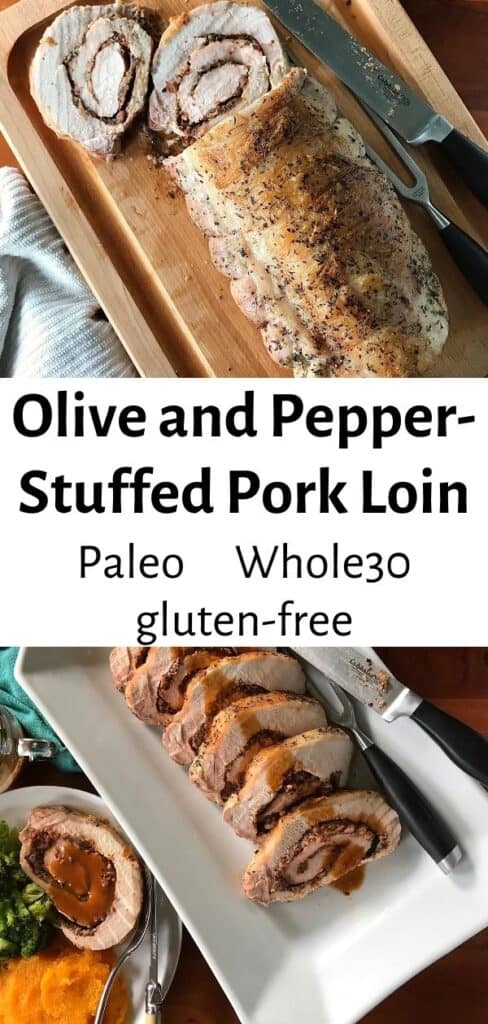
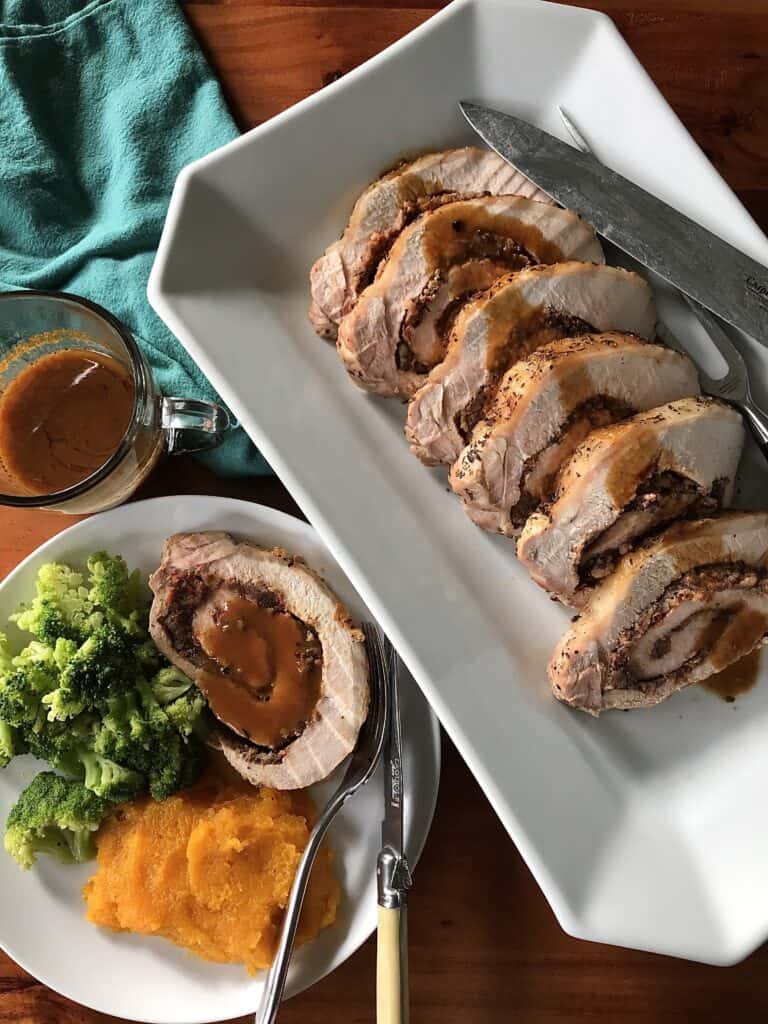

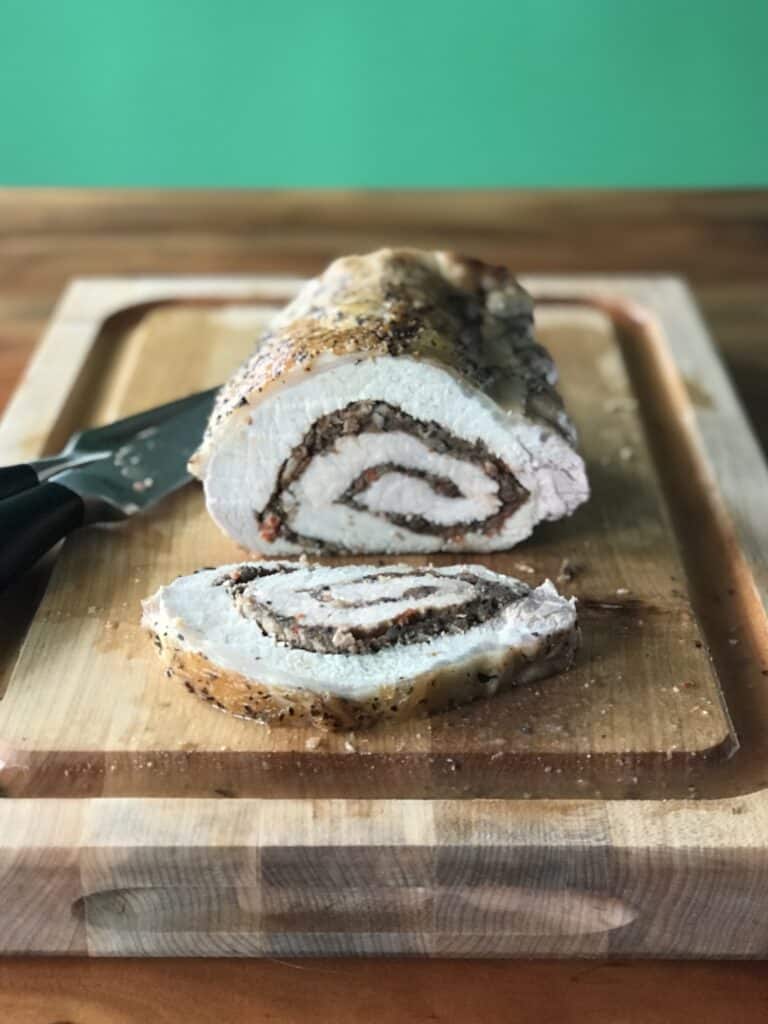
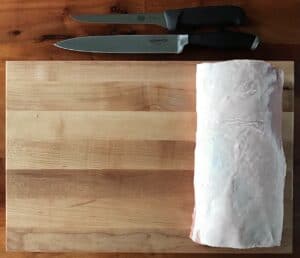
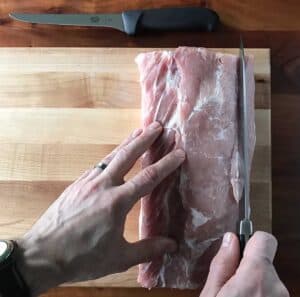
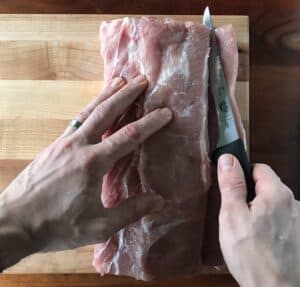
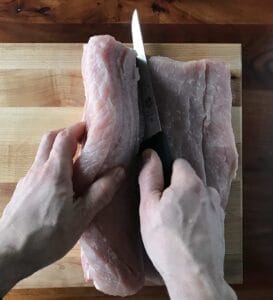
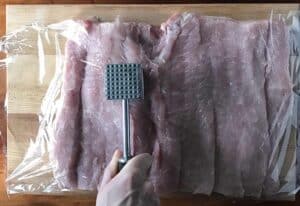
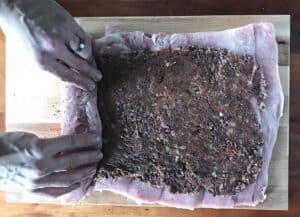
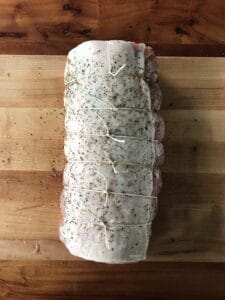

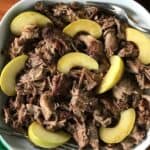

jennifer says
Capers and anchovies and olives, OH MY! yum, so much flavor and such a pretty presentation, I can’t wait to make this for my family.
Paleo Gluten Free Guy says
I hope you enjoy it!
ChihYu says
So elegant and delicious! That stuffing is divine – so many flavors!
Paleo Gluten Free Guy says
Thanks!
Megan Stevens says
This is so delicious and impressive. I actually love what the anchovies add!
Paleo Gluten Free Guy says
Thanks! Yes, anchovies are the best. 😉
Jean Choi says
The olives and pork just go perfectly together! Will need to make this over the holidays.
Paleo Gluten Free Guy says
Great! I hope you enjoy it.